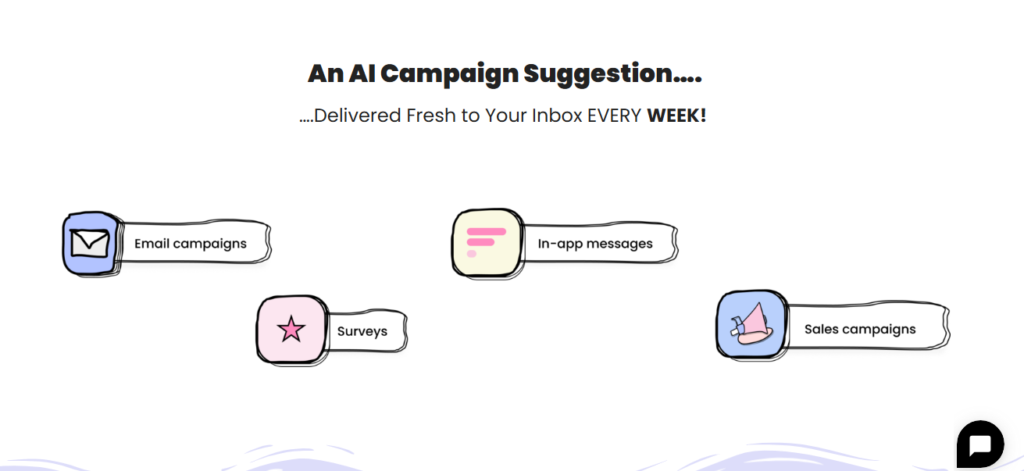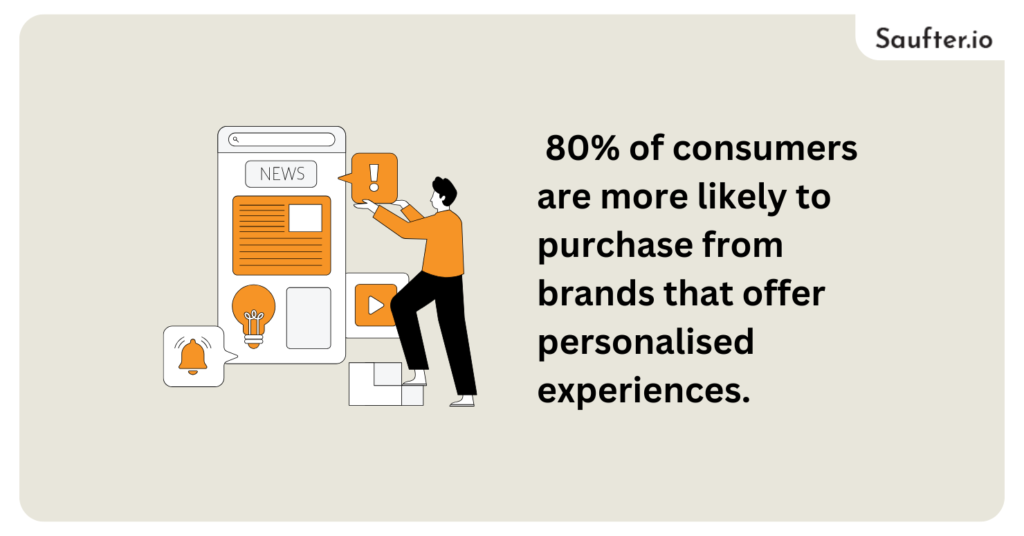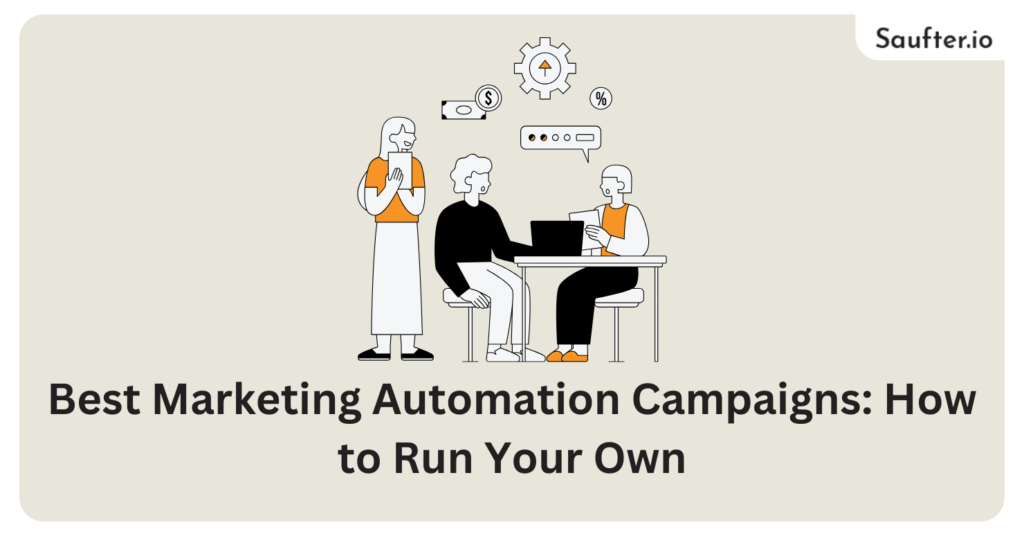Last Updated: December 2025
Harnessing the power of best marketing automation campaigns is integral for brands striving to enhance efficiency and engagement. Adopting automated strategies, from sending emails to scheduling social media posts, conserves valuable resources and enables data-driven marketing initiatives based on various elements, such as website traffic and user interactions. By 2030, the global marketing automation market is expected to hit $13.71 billion.

What is the Marketing Automation?
Marketing automation refers to technology designed to automatically manage marketing processes and multifunctional campaigns across multiple channels. It enables businesses to execute repetitive tasks efficiently, eliminating the need for manual intervention while ensuring consistent communication with customers. Typical functionalities of marketing automation include email marketing, social media posting, lead nurturing, and customer engagement tracking, which collectively enhance the effectiveness of marketing strategies.
As a result, businesses can improve lead generation and conversion rates, streamline their operations, and ultimately deliver personalised customer experiences at scale.Below are the awesome marketing automation campaigns that every organisation should prioritise in 2025 and beyond.
1. Welcome Campaign
A marketing automation strategy known as a “Welcome” campaign is essential to greatly increasing consumer engagement. If someone signs up for your email list, blog, or newsletter, you may start a conversation with them using this campaign. Make sure your subscribers know what to expect from your messages and convey your brand’s unique value proposition.
For example, Airbud’s welcome email showcases its offerings with an attractive style, powerful branding, and intriguing pictures. Think about these approaches to create a welcome campaign that makes a difference:
- Narrate your Brand story: If you want to engage with your readers on a deeper level, share your brand’s narrative and your unique selling point.
- Outline Expectations: Specify how often you will inform your subscribers and what they may expect to gain from receiving your emails.
- Motivate People: To engage new subscribers with your company immediately, delight them with unique deals or free material.
Workflow Setup
- Trigger: Set the trigger for this workflow based on the user’s subscription activity.
- Initial Email: Send a welcome email immediately after a person subscribes, introducing your brand.
- Follow-Up Emails: Schedule follow-up emails over the next week, providing insights about your offerings and additional resources.
2. Onboarding Campaign
The goal of an “onboarding” program is to help new customers get used to your product or service. This method works especially well for companies in the SaaS and FinTech industries, where teaching users is very important. During onboarding, users are usually sent a number of emails with guides, frequently asked questions(FAQs), and video tutorials that help them go from being new users to becoming active customers.
Onboarding efforts are used very well by companies like Slack, which makes it easy to sign up and has a friendly bot that walks new users through the platform’s main features. Follow these suggestions to make your onboarding effort better:
- First Contact: Send a welcome email once someone signs up.
- Follow-up mechanisms: Send users more information based on how well they complete the onboarding tasks.
- Showcase Product Features: Send informational emails that elucidate the product’s features once users have completed their initial onboarding tasks.
Workflow Setup
- Trigger: Initiate the workflow once a new user registers.
- First Email: Send a welcome email with initial instructions and resources.
- Sequential Emails: After a few days, send additional emails detailing specific features or providing user tips, depending on user interaction.
3. Win-Back Campaigns
Win-back campaigns are made to get customers who have stopped using or are interested in a product or service to use it again. Personalised reminders, special deals, or content made just for users who haven’t interacted in a while are common parts of these tactics. BuzzFeed and Adidas’ successful “win-back” ads use humour and eye-catching images to get people to return to the site and interact with it again.
Follow these steps to come up with a good win-back plan:
- Identify Inactive users: Look at the data to see which people haven’t interacted in a certain amount of time.
- Customise Messages: Make messages based on how you’ve interacted with users before and what they like.
- Use Multiple Channels: To reach users on the channels they prefer, send them emails and push notifications together.
Workflow Setup
- Trigger: Set triggers for users after a defined period of inactivity.
- Initial Email: Send a personalised email, possibly with a special offer, to entice them back.
- Follow-Up: If there’s no response, deliver another reminder offering additional incentives.
4. Behaviour- Based Campaigns
Behaviour-based ads use information about users to make experiences more relevant to them. Brands can tailor marketing messages to each person’s tastes by looking at how they browse and interact with the site. Companies like Nordstrom and Uber use this approach well by making sure that their users.
When planning a behavioural marketing strategy, keep these tips in mind:
- Effectively Gather Data: Collect information from different interactions with users to find trends in their behaviour.
- Segment Your Audience: Collect information from different groups so that you can send them messages that you can send them messages that are related to what they’re doing.
- Personalise Content: Use dynamic content to send the right word to the right user at the right time.
Workflow Setup
- Trigger: Initiate workflows based on specific user behaviours, like product views or clicks.
- Content Personalisation: Automatically adjust content to reflect users’ interests as they engage with your site.
- Follow-Up Messages: Send subsequent emails based on additional user actions for further engagement.
5. Feedback Campaign
The goal of the feedback campaign is to get customers’ opinions and ideas so that services or goods can be improved right away. These efforts are significant for keeping customers coming back and making them happier. Sending targeted emails or surveys to get feedback after important interactions can yield useful information that shapes future developments.
Some of the most important things you can do to make feedback programs work are:
- Targeted Timeframes: Send feedback requests soon after important exchanges, like when someone buys something or asks for help.
- User-Friendly Surveys: Make sure that the ways to give feedback are clear and offer rewards to people who complete them.
- Integration of Feedback Data: Use the information you’ve gathered to make your products better, your users’ experiences better, and to show that you care about what your customers think.
Workflow Setup
- Trigger: Set a trigger for feedback requests following significant customer actions.
- Send Survey: Email customers a concise survey directly after an interaction, like a purchase or service usage.
- Review Responses: Analyse the feedback collected to make informed decisions on product improvements.
6. Reminder Campaign
Reminder ads are meant to get people to use your site again by sending them personalised alerts about events or accounts that haven’t been used in a while. These efforts can work especially well in fields like media and entertainment that need to get people to participate. For instance, Netflix gives users reminders based on how often they watch shows and films, along with personalised suggestions to get them to come back to their platform.
If you want your reminder efforts to work, follow these steps:
- Explain Inactivity Metrics: Set criteria for when reminders should be sent based on how inactive a person is.
- Offer Customised suggestions: To get people to come back to the platform, show them personalised video suggestions.
- Look at the results of the engagement: Keep an eye on projects to see how well they’re doing so that they can be improved even more.
Workflow Setup
- Trigger: Set inactivity benchmarks for users to receive reminders.
- Personalised Reminder Email: Send a reminder featuring personalised suggestions after meeting the inactivity threshold.
- Follow-Up: If engagement does not increase, consider additional follow-ups with new content or incentives.
7. Re-engagement Campaigns
Targeting former customers in a smart way is what re-engagement strategies do to get them to come back. This method uses techniques that are designed to reach people who have left items in their shopping carts or stopped interacting with a brand. Emails like Sephora’s that are meant to get people to re-engage create a sense of urgency with messages like “Hurry, this may sell out,” making people more likely to buy immediately.
To make a strong re-engagement program, you should:
- Establish Triggers: Identify key moments when outreach is necessary by analysing user engagement levels.
- Incorporate Attractive Incentives: Offer discounts or highlight product availability to motivate users to return.
- Conduct A/B Testing: Personalise various engagement strategies to determine which messages yield the best results.
Workflow Setup
- Trigger: Activate the campaign upon detecting inactivity based on user behaviour.
- Engagement Email: Send an email highlighting urgency or limited-time offers to prompt action.
- Monitor Results: Evaluate the effectiveness of different approaches and refine strategies accordingly
By implementing these strategies and workflows, organisations can effectively leverage marketing automation campaigns to boost engagement and conversion rates.
Customer Relationship Management and Marketing Automation: An Integrated Approach to Enhancing Business Outcomes
Customer Relationship Management (CRM) and marketing automation are two interconnected systems that play essential roles in modern businesses. Each serves unique purposes but can enhance overall efficiency and effectiveness when used in tandem. This report delves into their distinct features, operational mechanisms, benefits, and integration strategies.
Definitions and Core Functions
CRM refers to systems designed to manage a company’s interactions with current and potential customers. It centralises customer data, facilitating better communication, relationship management, and service delivery. The primary functions of CRM include:
- Contact Management: Storing and managing customer details and interaction histories.
- Sales Management: Streamlining sales processes by tracking opportunities and performance metrics.
- Analytics: Providing insights into customer behaviour and sales trends to inform strategy.
On the other hand, marketing automation focuses on streamlining and automating marketing tasks to optimise customer outreach. Key functionalities of marketing automation systems comprise:
- Email Campaign Automation: Sending personalised emails based on customer behaviour, such as triggered communications following specific interactions.
- Lead Nurturing: Automating the tracking and engagement of leads through tailored content strategies.
- Analytics and Reporting: Offering insights to refine marketing efforts based on engagement metrics and campaign performance.
Benefits of CRM and Marketing Automation
The combination of CRM and marketing automation provides numerous benefits for organisations. Key advantages include:
- Enhanced Customer Insights: By integrating data from both systems, businesses can achieve a holistic view of customer interactions and preferences. This unified data enables more personalised marketing efforts aimed at customer needs, significantly improving engagement results.
- Improved Efficiency: Automation reduces the need for manual intervention in repetitive tasks. For instance, CRM can automatically update customer details from marketing interactions, while marketing automation can trigger follow-up messages based on actions taken by customers.
- Better Lead Management: CRM systems can score and prioritise leads based on data collected by marketing automation tools. This ensures that sales teams focus on the most promising prospects, increasing conversion potential.
- Streamlined Processes: Integration of CRM and marketing automation enables seamless workflows across teams. This cross-functional coherence allows teams to work collaboratively, enhancing the overall customer experience.
Integration Strategies
For businesses to maximise the benefits of both CRM and marketing automation, successful integration is crucial. Consider the following strategies:
- Select Compatible Platforms: Choose systems that offer robust integration options. Many CRM systems now support native integrations with popular marketing automation tools, facilitating smoother data flow and operational synergy.
- Ensure Data Consistency: Maintain accurate, real-time data synchronisation between both systems. Regular audits can help identify and rectify any discrepancies that may arise, ensuring a single source of truth for customer data.
- Create Unified Workflows: Develop automation workflows that leverage data from both systems. For example, once a lead reaches a specific score in CRM, trigger targeted email campaigns via the marketing automation system to nurture that lead further.
- Train Staff on Integrated Use: Educating staff on how to leverage the integrated systems effectively is vital. Training should cover how to interpret data, automate processes, and utilise insights gained from both platforms for strategic decision-making.
In closing, the relationship between CRM and marketing automation is pivotal for businesses aiming to enhance customer interactions and optimise marketing efforts. By understanding their distinct functions and integrating them effectively, organisations can improve operational efficiency, boost customer satisfaction, and increase sales conversion rates. The strategic use of both systems can lead to significant competitive advantages in today’s data-driven market environment.
Saufter: An Exceptional Email Marketing Automation Tool

Saufter is an intelligent customer engagement and email marketing tool that leverages advanced analytics to enhance your campaigns. By examining user behavior on your website or portal, it provides tailored recommendations to help you connect with your audience more effectively.
For example, Saufter can suggest a “how-to” article for a feature a user hasn’t yet interacted with. Each week, you’ll receive pre-drafted email and in-app campaigns that only require your approval, saving time and ensuring precision.
What sets Saufter apart is its ability to monitor competitors, analyzing their content to recommend campaigns based on their latest blog posts. This keeps your marketing strategy fresh and competitive.
Key Features:
Effortless User Segmentation: Automatically organize users into behavior-based cohorts.
Smart Campaign Recommendations: Receive AI-driven suggestions to boost conversions and minimize churn.
SEO Campaign Optimization: Unlock actionable insights for SEO-focused campaigns.
Behavior Predictions: Use AI to forecast customer actions and proactively prevent churn.

Implementing the best marketing automation campaigns is crucial for businesses looking to enhance customer engagement and streamline costs. 80% are more likely to purchase from brands that offer personalised experiences. By strategically utilising welcome, onboarding, win-back, behavioural, reminder, and re-engagement campaigns, marketers can cultivate sustained customer relationships while maximising returns on investment.
With tools such as Saufter providing advanced features to facilitate these strategies, brands are better equipped to navigate the market’s evolving needs.
















